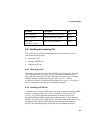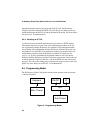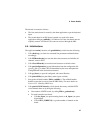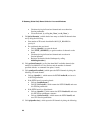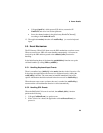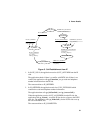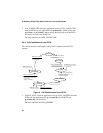6. Demo Details
33
2. In PSTN_OFFERED the application waits for GCEV_CONNECTED from
the IP side.
When the application receives GCEV_CONNECTED it calls:
• gc_Extension( ) to get the call information from the IP side
• gc_Listen( ) to tell the IP line device to listen to the PSTN time slot
• pstnListen( ) which calls ag_Listen( ) or dt_Listen( ) (ag for analog; dt for
digital) to tell the PSTN line device to listen to the IP time slot
• gc_AnswerCall( ) to answer the call on the PSTN
The state transitions to IP_CONNECTED.
3. In IP_CONNECTED, when the application receives GCEV_ANSWERED
from the PSTN the state transitions to GATE_CONNECTED.
6.6.3. Call Teardown
1. When either side (PSTN or IP) sends a GCEV_DISCONNECTED event in
any state except for IP_OFFERED, the application calls gc_Unlisten( ) for
the IP side and ag_Unlisten( ) or dt_Unlisten( ) for the PSTN side. The
application also calls gc_DropCall( ) for both sides of the call to disconnect
the call.
The state transitions to GATE_DROP.
2. When the application receives GCEV_DROPCALL from both sides the
application calls gc_Extension( ) to get RTCP information for the call.
When the application receives GCEV_EXTENSION with the RTCP
information it calls gc_ReleaseCall( ) to release the call.
The state then transitions to GATE_RELEASE.
3. When the application receives a GCEV_RELEASECALL event it sends
IPTResetSession() and the call state transitions to GATE_NULL.
If a GCEV_DISCONNECTED event is received from the IP side when the state is
IP_OFFERED:
1. The application calls gc_DropCall( ) for the IP side and the state transitions
to IP_DROP.



